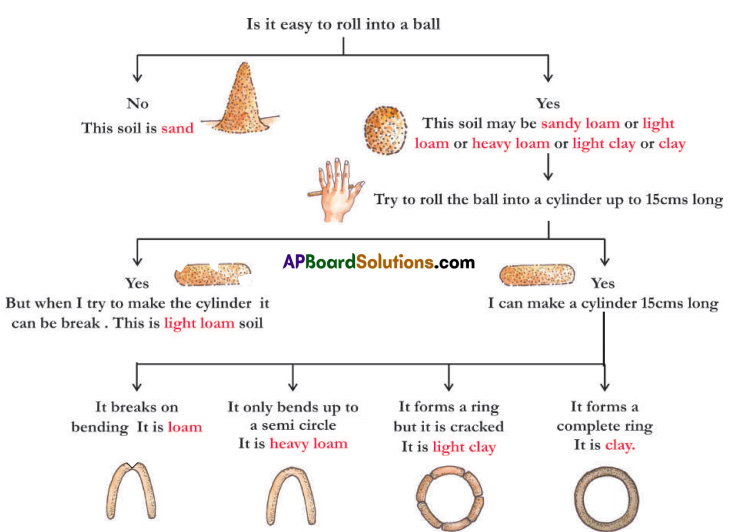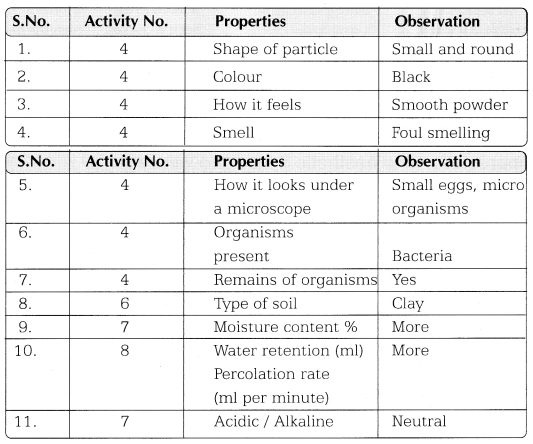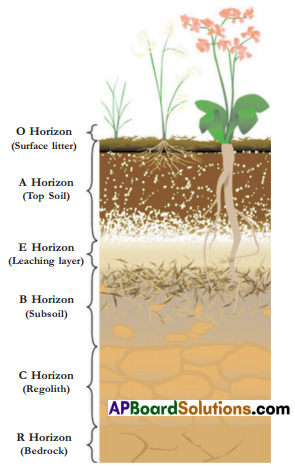These TS 7th Class Science Important Questions 15th Lesson Soil: Our Life will help the students to improve their time and approach.
TS 7th Class Science Important Questions 15th Lesson Soil: Our Life
Question 1.
Guess why soil of the garden is not suitable to make models.
Answer:
In general the soil in the garden consists sandy particles. We can’t make models with sandy soil. So soil of the garden was not suitable to make models.
Question 2.
Are soils different from place to place?
Answer:
Yes, soils are different from place to place.
![]()
Question 3.
How is soil useful for us?
Answer:
- Soil supports all living organisms.
- Soil supports all plants.
- Soil is used for agriculture.
- Soil is used for making bricks, utensils, toys etc.
Question 4.
What are the components of soil?
Answer:
Soil is made up of tiny sand particles, organic matter and minerals.
Question 5.
Can we say soil is one of the most important resources like water and air? Why?
Answer:
Yes, it supports the existence of living organisms. All the things in our surroundings directly or indirectly depend on soil.
Question 6.
Let us do:
Complete the following table.
Answer:
| S.No. | Things directly related to soil | Things indirectly related to soil |
| 1. | Pot | Wooden chair |
| 2. | Brick | Food grains |
| 3. | Clay wall | Earthworms |
| 4. | Bricks | Metal objects |
| 5. | Utensils, Toys | Clothes |
Question 7.
Which area has a maximum of animal life ?
Answer:
- Animal life is maximum at the place where humus exists.
- Maximum of animal life is also at lake side, open meadows, river banks, road side. These places have sufficient water for animal life.
Question 8.
Does the amount of animal life and the burrows of the animals have any relation to the condition of the soil ?
Answer:
- More burrows are seem in the fertile soil area. Fertile soil leads maximum animal life.
- At cultivated soil, the life of animals is maximum.
- The relation between animal life and the nature of the soil is interlinked.
![]()
Question 9.
Define “soil erosion”.
Answer:
Removal of top soil by wind, water or any other means is known as soil erosion.
Question 10.
Which crops are grown one after another in your village ?
Answer:
The first crop grown in our village is paddy. After paddy we cultivate pulses like black gram, yellow gram.
Question 11.
Why are pulses grown every time ?
Answer:
Pulses are grown every time because these crops retain soil fertility and productivity.
Question 12.
Write different types of Horizons of soil and write the features.
Answer:

Question 13.
Is there any crop that grows continuously in a same field?
(or)
What would happen if same crop is cultivated continuously in the same field?
Answer:
- No, same crop cannot be grown continuously in the same field.
- It decreases the soil fertility.
- Yield decreases in the next crop.
- Conservation of soil is important factor in agriculture.
![]()
Question 14.
What questions you would ask a soil scientist to know the nature of soils?
Answer:
- Why should we know the nature of soil?
- What type of soil is useful for plants?
- Are all the soils same throughout the world?
- If the soil is spoiled, what would happen?
Question 15.
How do you observe soil insects?
Answer:
- Let us measure and mark an area of land approximately 30 cm X 30 cm.
- It is gently sorted through the leaf litter.
- Creatures are collected and recorded.
- The soil is dug up upto a depth of 4-6 cm.
- The presence of roots are observed and recorded.
- Then soil is taken and spread on a sheet of news paper.
- It is sorted and watched with a hand lens closely for small living things.
- Worms, eggs of insects, burrows and other animals are observed and recorded all the observations.
Question 16.
How do you determine and classify the type of soil that is collected. Give the answer with simple technique.
Answer:

Question 17.
How do you find the moisture content of soil?
Answer:
Grind the soil into a fine powder. Weigh 100 gms of soil from this pile. Spread it on a news paper and dry it for about two hours, While drying the soil, the sky must be clear and the heat of the sun, intense. Keep turning the soil over while drying it.
Be careful that the soil does not spill out of the news paper. Weigh the soil again after it is completely dried. The difference in the two weights gives how much water 100 gm of the soil contained. This quantity is known as the percent moisture content of the soil.
![]()
Question 18.
How do you know the percolation rate of soil?
Answer:
Take a plastic funnel and place a filter paper in it as shown in the figure. Weigh 50 gms of dry soil and pour it into the funnel. Take 100 ml of water in a measuring cylinder. Then pour water on the soil drop by drop. Do not let all the water fall at one spot.

Pour water all over the surface of the soil until it starts dripping out of the funnel. Observe how fast water passes down the soil. Measure the amount of water collected in the beaker. Calculate the difference between the amounts of water. Record the time taken for water to pass through the sample.
Question 19.
First copy the following table in your notebook and note all observations in this table.
(Or)
Write the observations you made based on the properties of soil according to the activities done by you. Tabulate the information.
Answer:

Question 20.
Draw a figure showing the Horizons of soil.
Answer:

Question 21.
Draw the diagram showing experiment on finding out substances present in the soil?
Answer:

Question 22.
Rafi’s grandma said “To make models, you have to collect sticky soil from the bank of OUF village pond”. Why was Grandma’s suggestion useful?
Answer:
The soil from the bank of village pond is black clay and consists of less amount of sand. Models prepared with this black clay won’t break easily. This black clay is sticky.
![]()
Question 23.
Write the consequences due to over usage of plaster of paris in making Vinayaka idols on Vinayaka Chavithi festival.
Answer:
- On Viriayaka Chavithi festival, people use idols of Ganesh made of plaster of paris and chemical colours which cause severe damage to our environment and also harmful to our health.
- Immersing these idols into the water causes water pollution.
Question 24.
How do we celebrate Vinayaka Chavithi festival without affecting the environment?
Answer:
- Instead of using plaster of paris for making idols, we should use clay.
- Use natural colours but not artificial colours.
- Clayey soil and natural colours wont cause pollution.
Question 24.
How do we celebrate Vinayaka Chavithi festival without affecting the environment?
Answer:
- Instead of using plaster of parís for making idols, we should use clay.
- Use natural colours but not artificial colours.
- Clayey soil and natural colours won’t cause pollution.
Question 25.
“Soil is a good habitat”. Explain the statement.
Answer:
The living place of all living organisms is called a ‘habitat’, Soil is used for agricultural and Construction purposes, making utensils, toys etc. Different types of plants and animals are living on the soil. So, soil is a good habitat.
Choose the correct answer:
I. Conceptual Understanding
Question 1.
The soil used for toys ( )
A) Red soil
B) Sandy soil
C) Clay soil
D) Light clay soil
Answer:
C) Clay soil
![]()
Question 2.
Thing directly related to soil is ( )
A) chair
B) pot
C) belt
D) almirah
Answer:
B) pot
Question 3.
On Vinayaka Chavithi festival, idols are prepared by ( )
A) wood
B) wax
C) metal
D) clay
Answer:
D) clay
Question 4.
The relation between nature of soil and number of animals ( )
A) More beneficial to all
B) No benefit to organisms
C) Not comparable
D) None of these
Answer:
A) More beneficial to all
Question 5.
Soil is used in pottery is ( )
A) red soil
B) clay soil
C) sand soil
D) loam soil
Answer:
B) clay soil
Question 6.
Pots are made by using clay soil on a ( )
A) pot
B) potter wheel
C) potter stick
D) potter utensil
Answer:
B) potter wheel
Question 7.
Soil used for making a ball. ( )
A) Sand soil
B) Loam soil
C) Light clay soil
D) Clay soil
Answer:
A) Sand soil
![]()
Question 8.
Water holding capacity is more in the soil ( )
A) Sand soil
B) Loam soil
C) Light clay soil
D) Clay soil
Answer:
D) Clay soil
Question 9.
Water holding capacity is less in the soil ( )
A) Sand soil
B) Loam soil
C) Clay soil
D) Light clay soil
Answer:
A) Sand soil
Question 10.
…………… is called the sub soil ( )
A) O – Horizon
B) B – Horizon
C) E – Horizon
D) A – Horizon
Answer:
B) B – Horizon
Question 11.
The unweathered rock layer is ( )
A) B – Horizon
B) E – Horizon
C) R – Horizon
D) A – Horizon
Answer:
C) R – Horizon
Question 12.
…….. are grown in sandy soil ( )
A) Vegetables
B) Piddy
C) Cotton
D) Sugar cane
Answer:
A) Vegetables
![]()
Question 13.
Making pots by using soil is called ( )
A) clay
B) mixing
C) pottery
D) crockery
Answer:
C) pottery
Question 14.
Water passing down through the soil particles is called ( )
A) sedimentation
B) percolation
C) sedentation
D) prevention
Answer:
B) percolation
Question 15.
Removal of top soil is known as ( )
A) soil erosion
B) soil conservation
C) soil fertility
D) soil defect
Answer:
A) soil erosion
Question 16.
Soil is formed of rock particles and organic matter called … ( )
A) funmus
B) rocks
C) humus
D) hills
Answer:
C) humus
Question 17.
If large and fine particles are present in equal proportions, the soil is called ( )
A) loam
B) sand
C) rocky
D) percolated
Answer:
A) loam
![]()
Question 18.
If dumping of cattle dung in the field, what would be the benefit to the soil? ( )
A) Retains water
B) Retains soil
C) Retains plants
D) Retains the fertility
Answer:
D) Retains the fertility
Question 19.
Why do farmers cultivate pulses after paddy? ( )
A) to add nutrients to the soil
B) to remove water from the soil
C) to lift water in the soil
D) all the above
Answer:
A) to add nutrients to the soil
Question 20.
Find out the odd one regarding types of soils. ( )
A) Clay
B) Acidic
C) Loam
D) Sandy
Answer:
B) Acidic
Question 21.
Loam soil : breaks on bending: : clay: ________? ( )
A) cracks after wet
B) loose soil
C) can form ring
D) bends upto semicircle
Answer:
C) can form ring
Question 22.
In order to know the substances in the soil, the drained water is heated in the test tube until _____ ( )
A) one fourth of water remains
B) two fourth of water remains
C) three fourth of water remains
D) full water is exhausted
Answer:
A) one fourth of water remains
![]()
Question 23.
This soil bends upto a semicircle. ( )
A) Loam
B) Heavy loam
C) Light clay
D) Clay
Answer:
B) Heavy loam
Question 24.
What organisms were found in the soil, when the soil was observed carefully with hand lens? ( )
A) Worms
B) Eggs of insects
C) Snakes
D) A and B
Answer:
D) A and B
Question 25.
Read the paragraph and answer the questions. ( )
During festivals like Vinayaka Chavithi, people use idols of Ganesh made of 1 plaster of paris and chemical colours which cause severe damage to our environment.
Q. What type of idols to be made instead of plaster of paris? ( )
A) idols with cement
B) clay idols
C) plastic idols
D) iron idols
Answer:
B) clay idols
Question 26.
Why farmers grow grass and other plants in the vacant lands? ( )
A) To loose the soil
B) To erode the soil
C) To prevent water
D) To prevent soil erosion
Answer:
D) To prevent soil erosion
![]()
Question 27.
The soil becomes as it is seen in the picture after rolling. What type of soil it is? ( )

A) Clay
B) Loam
C) Heavy loam
D) Light loam
Answer:
B) Loam
Question 28.
Read the graphical representation of soil. What is present in the C-Horizon of soil layers?

A) Leaching
B) Bed rock
C) Subsoil
D) Regolith
Answer:
D) Regolith
Question 29.
Conservation of soil leads to ( )
A) good agri farming
B) soil erosion
C) good forestry
D) soil removal
Answer:
A) good agri farming
Question 30.
The crop that grows best in a field that remains tilled with water for a long time. ( )
A) Wheat
B) Cotton
C) Paddy
D) Ground nut
Answer:
C) Paddy
![]()
Question 31.
The result of soil erosion ( )
A) soil becomes strong
B) soil becomes vulnerable to natural calamities
C) soil becomes fertile
D) all the above
Answer:
B) soil becomes vulnerable to natural calamities